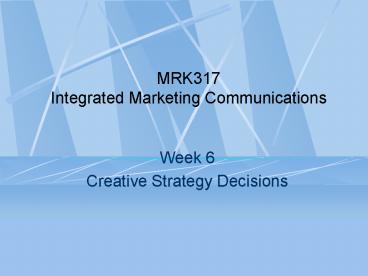MRK317 Integrated Marketing Communications - PowerPoint PPT Presentation
1 / 24
Title: MRK317 Integrated Marketing Communications
1
MRK317Integrated Marketing Communications
- Week 6
- Creative Strategy Decisions
2
Re-cap from last week
- Why set objectives?
- What is the difference between marketing and
communication objectives? - Explain the DAGMAR approach for setting
objectives any problems? - Communication Objectives three parts?
3
How Planning Works
- Three critical tasks in planning
- Setting measurable objectives
- Deciding on strategies
- Choosing tactics
4
- What is creativity?
5
Importance of Advertising Creativity
- Good creative strategy is often central to
determining the success of a product or service. - Advertising campaign that is poorly conceived or
executed can be a liability. - An ad or commercial that is creative does not
mean it will effectively communicate the intended
message.
6
Definition of Advertising Creativity
- Ability to generate fresh, unique and appropriate
ideas to solve communications problems. - To be appropriate and effective the idea must be
relevant to the target audience. - Break through the clutter.
7
Creative Challenges
- Creative specialists face challenge of taking
research, creative briefs, strategy statements,
communication objectives and other input and
transforming them into an advertising message. - Many people follow a proven formula when creating
ads, because they are safe.
8
Creative Personnel
- Use their artistic talents to translate
communication objectives into advertising
campaign. - Account planning plays important role during
creative strategy development by driving process
from the customers point of view.
9
Creative Process
- Wallas Four-Step Approach
- Preparation
- Gathering background information
- Incubation
- Idea development
- Illumination
- Seeing the solution
- Verification
- Refining the idea and finding the appropriate
solution
10
Verification and Revision
- Techniques used
- Directed focus groups
- Message communication studies
- Portfolio tests
- Viewer reaction profiles
- Storyboard
- Series of drawings used to present the visual
plan or layout of a proposed commercial
11
Copy Platform Outline
- 1 Basic problem or issue the advertising must
address. - 2 Target audience and behaviour objective.
- 3 Communication Objective.
- 4 Brand positioning statement.
- 5 Creative strategy statement (campaign theme,
appeal, source characteristics). - 6 Supporting information and requirements.
12
Creative Theme/Idea
- Campaign theme
- Should be a strong idea
- Central message that will be communicated in all
advertising and other promotional activities - Short term in nature, done on annual basis
13
Creative Theme/ Idea
- Best approaches for developing effective
advertising - Using a unique selling position
- Creating a brand image
- Finding the inherent drama
- Positioning
14
Unique Selling Proposition
- Benefit
- Buy this produce and you'll benefit this way or
enjoy this reward - Unique
- Must be unique to this brand or claim Something
rivals can't or don't offer - Potent
- The promise must be strong enough or attractive
enough to move people
15
Creating a Brand Image
- David Ogilvys approach
- Brand image or personality is particularly
important when brands are similar - Every ad must contribute to the complex symbol
that is the brand image
16
Finding the Inherent Drama
- Characteristic of the product that makes the
consumer purchase it - Leo Burnetts approach
- Find the inherent drama or characteristic of the
product that makes consumers buy it - (Inherent drama) is often hard to find but it is
always there, and once found it is the most
interesting and believable of all advertising
appeals.
17
Positioning
- Establish the brand position in the consumers
mind - Done for companies as well as brands
18
Message Appeals
- Approach used to attract the attention of
consumers and /or influence toward the product or
service - Types of appeals
- Rational appeals
- Emotional appeals
- Fear appeals
- Humour appeals
19
Message Appeals
- Rational, Humour, Emotional, Fear
- Describe what is meant by each type of appeal.
- What are some pros and cons of each type of
appeal? - Think of an ad that is using each type of appeal.
20
Source Characteristics
- Source credibility
- Source attractiveness
- Source power
21
Source Credibility
- Credibility the extent to which the recipient
sees the source as having relevant knowledge,
skill or experience and trusts the source to give
unbiased, objective information
22
Source Credibility
- Applying expertise
- Use communicators with high credibility
- Applying trustworthiness
- Target audience must find the source believable
23
Source Attractiveness
- Applying likeability using celebrities
- Draw attention to advertising message
- Popular celebrity will influence consumers
feelings, attitudes and purchase behaviors - Understanding the meaning of celebrity endorsers
- Applying likeability decorative models
24
Source Power
- Source has power when he or she can actually
administer rewards and punishments to the
receiver































